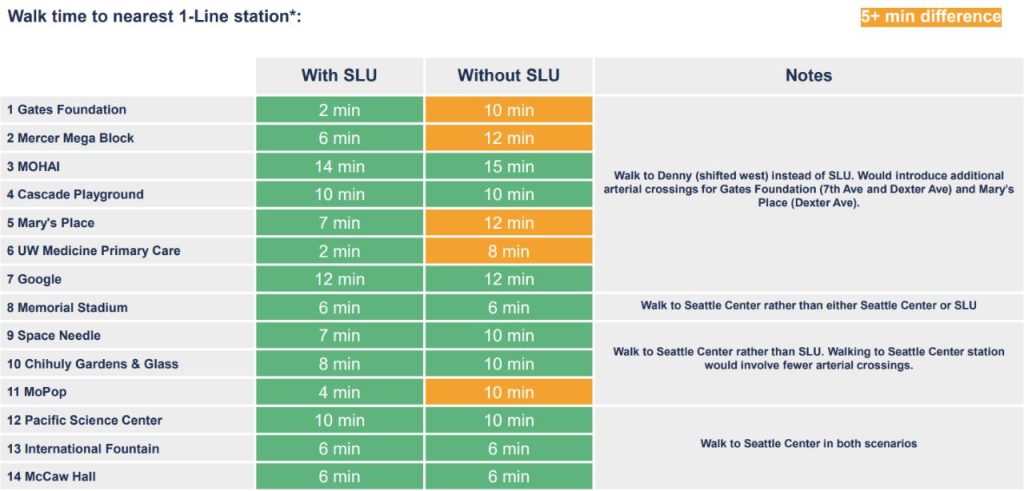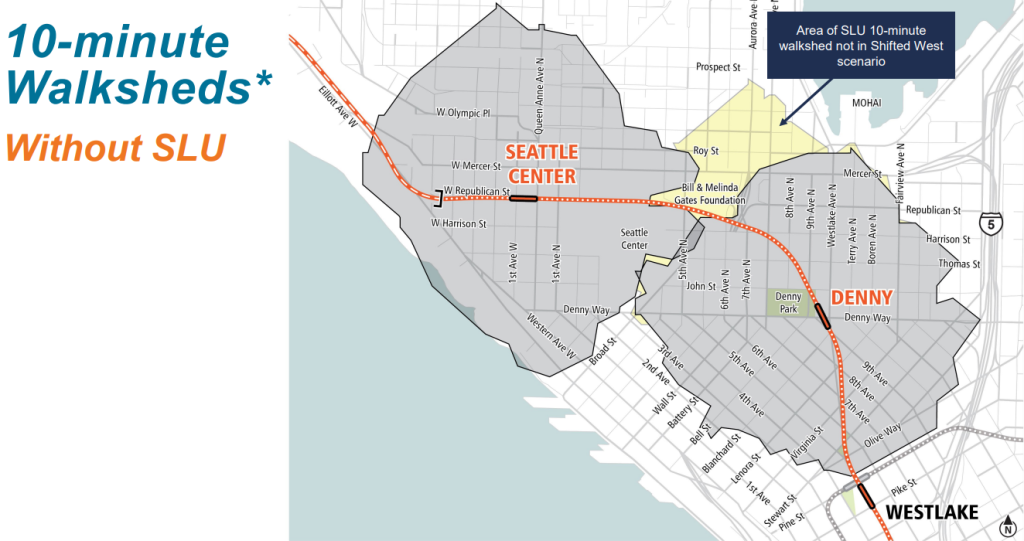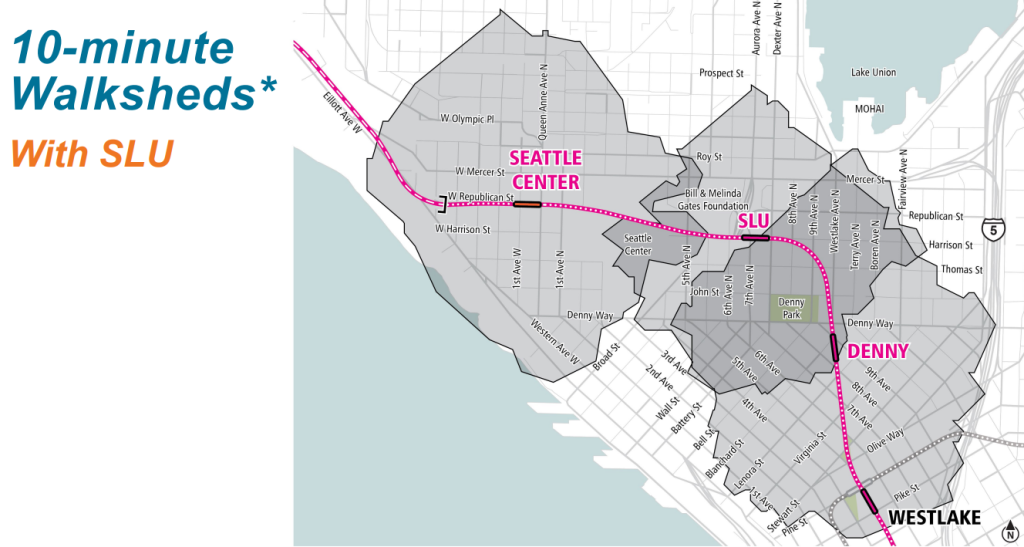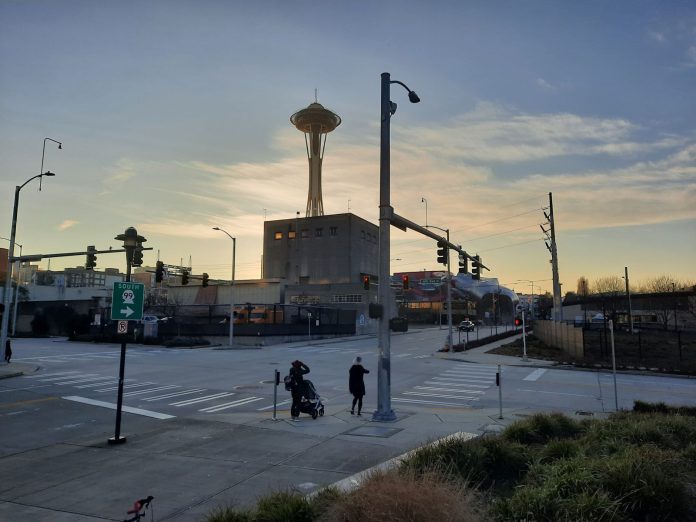
The move appeases advocates who fought to save a critical South Lake Union light rail station on Harrison Street that would have been cut.
Transit advocates scored a reprieve this month after Mayor Bruce Harrell backed away from his support for a “Shifted West” Denny Station that would have forced cutting the South Lake Union Station planned nearby at Harrison Street near Aurora Avenue. An outpouring of support for the station pushed Harrell to get behind the Westlake Avenue option that has been the default preferred alternative since Sound Transit began planning the light rail line in 2016.
Backers of the Shifted West alternative include Amazon, Vulcan Real Estate, and other major employers and landowners in North Downtown, who lobbied hard to get the new alternative added late into the process. Their hopes that jettisoning the South Lake Union station would not hurt ridership figures appear to have been in vain. Sound Transit briefed the Uptown Alliance on the proposal on Tuesday and revealed that agency projections showed that overall daily Link ridership would drop by about 10,000 without South Lake Union Station, representing a 5% drop for Ballard Link overall.
At a System Expansion Committee meeting on July 13, Harrell spoke at length about his shifting thinking on the South Lake Union and Denny stations.
“I don’t see how we can, based on the data we have, talk about losing a station South Lake Union and Harrison, which really leads us to the DT-1 preferred alternative with, again, an emphasis on further mitigating the impacts of construction on our community,” Harrell said. “Quite frankly, I talked about how this area is one of our greatest job engines in our entire region, and I continue to be concerned about the loss of Harrison station. So if there’s one word that resonates in my mind it is, what will that mitigation look like? What is the impact on transit?”
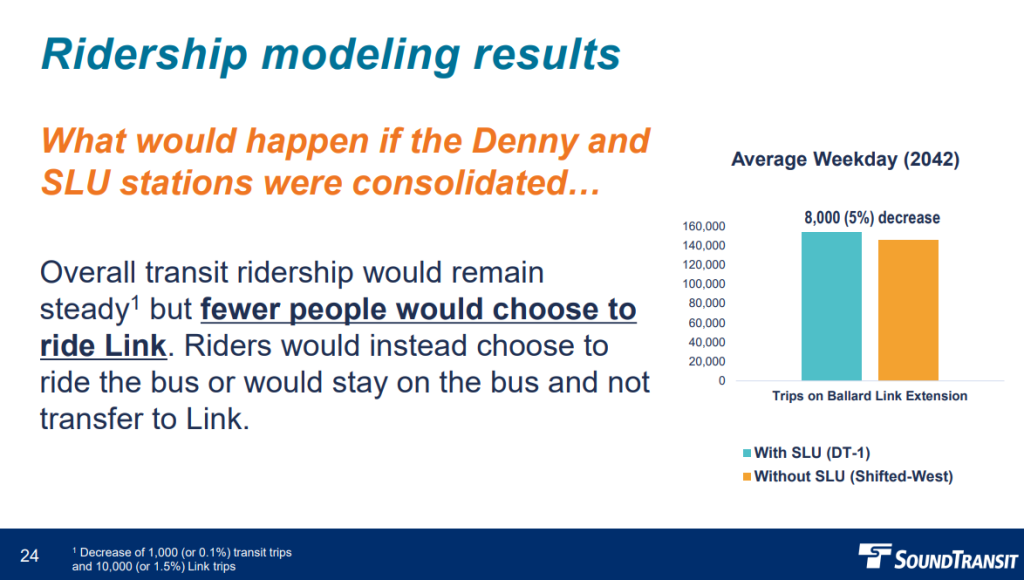
Previous to the meeting, Harrell had hoped that a Shifted West alternative could somehow pair with the Harrison station, even as staff warned the turn was too tight and the distance between the stations too close together at about a quarter-mile. Harrell and other Shifted West backers had pushed the agency to look at shifting the Harrison Station west too in order to save it, but that didn’t pan out with a feasible option, as Sound Transit’s Executive Corridor Director Cathal Ridge explained to boardmembers, and pursuing the idea certainly would delay the project.
“It would require that you locate that station on the area where Memorial Stadium is currently located. There are plans for redeveloping that area so that would be a conflict,” Ridge said. “That station location takes the station away from where the the bus lines would be on Aurora Avenue so you’re not getting that strong bus-to-rail connection, which is one of the objectives of that station location. And it’s a new idea; so, it’s an idea that if you were interested in looking at further I want to be clear would take additional time to examine further.”
Ridge also explained that the agency has determined decking is possible over the station pit on Westlake Avenue, which would allow some the road to remain open overhead. Otherwise, a full four-year closure of Westlake Avenue just south of Denny Street would have been required, according to Sound Transit. This would alleviate what appears to be the biggest concern coming from major employers.
Advocates warned of the negative impact that losing South Lake Union station could have on riders region-wide and on the surrounding neighborhoods. A Seattle Subway online petition to save the station gained more than 6,000 signatures and Uptown Alliance sent more than 200 letters.
Impacts to riders quantified
Debi Frausto with Uptown Alliance told The Urbanist that transit riders would pay the price in hours wasted in needlessly long commutes.
“It’s easy to say, oh, what’s 10 minutes here, six minutes there, but in the transit world of where you’re doing this commute every day, it is a chunk of time. And it can be avoided. And it can make life better,” Frausto said.
Without a South Lake Union Link station, transit riders are robbed of a quick connection to the Link light rail network and instead spend longer time on slower buses. “Someone at Dexter and Mercer who might have chosen Link to get to Westlake Center via a three-minute walk to the SLU station instead chooses to ride the 62 bus,” which “could add six to ten minutes to the trip,” Sound Transit’s presentation said.
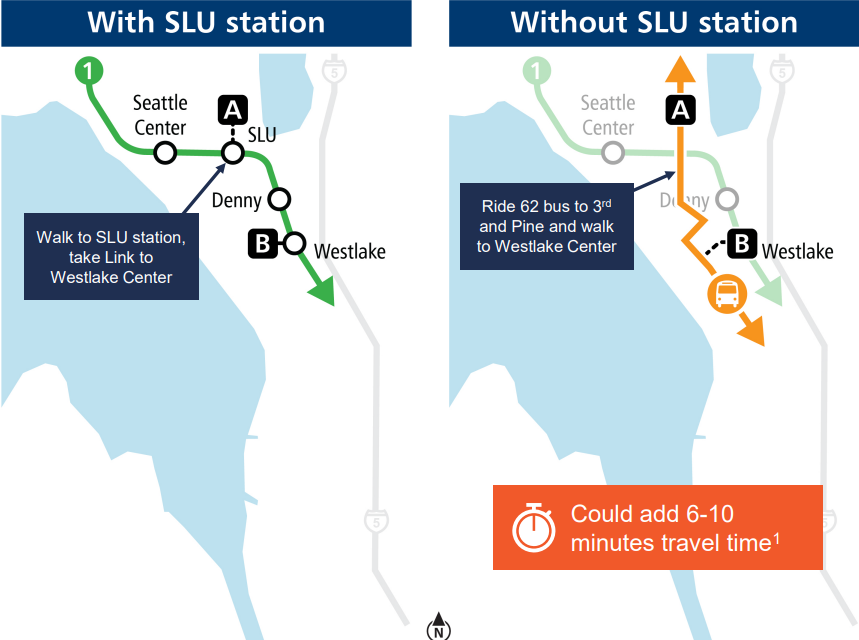
Not building South Lake Union Station would leave a significant gap in the 10-minute walkshed of Ballard Link, losing significant parts of Uptown (also known as Lower Queen Anne), Belltown, and South Lake Union. The agency’s analysis found that in such a scenario about two dozen blocks fall out of the 10-minute walkshed of light rail in a swath stretching from the Bill and Melinda Gates Foundation to the edge of Lake Union Park.
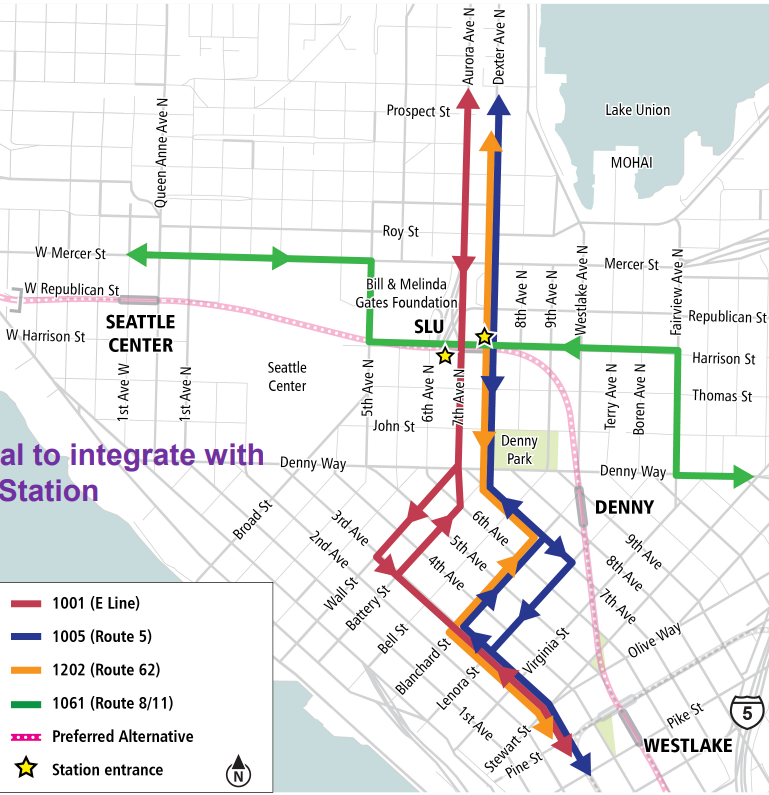
Among the biggest losers in light rail access would be South Lake Union’s Mary’s Place homeless shelter, the Mercer Mega Block (where a huge biomedical campus will soon be built), the Gates Foundation, MoPop museum, and the UW Medicine primary care center, as shown in the chart below. Walk time to the nearest Ballard Link station would increase by as much as 12 minutes for these destinations without the Harrison station.
The Broad Street corridor in Uptown and Belltown also see gaps and longer walks without the promised station. Belltown has already slipped between the cracks of Sound Transit’s expansion plans despite being the densest neighborhood in the state. The SLU station helps provide a viable walkshed to the northern section of Belltown while also providing superior bus integration for the entire neighborhood.
Uptown had long counted on both the eponymous Uptown station on the western end of the neighborhood and also a South Lake Union station serving the eastern side as it added large apartment buildings, expanded event capacity at the Seattle Center, and planned for a denser, more urban future. Abandoning the station would upset those plans.
“When we go back to the days of working with South Lake Union and the different neighborhoods of why a station here, it was because we knew that Uptown is a urban center,” Frausto said. “It’s meant to be part of the Growth Management Act. It’s meant to take on density. Both South Lake Union and Uptown at that point we’re going through their rezoning. Well that rezoning is completed. Now, if you walk through that area, you see the infrastructure that these two neighborhoods have put in place predicated really on that there’s going to be a transit station here, and that we can support it. And to then suddenly have that kind of a loss happen, it just didn’t make any common sense to us.”
Sound Transit was careful to note its walking distance are averages not indicative of all people, since some people walk slower. A Link walkshed map for people with disabilities or towing kids would show significantly larger gaps, as Maria Barrientos, who chairs Uptown Alliance’s land use committee and is also a prominent developer, noted.
“Did they take into account people with mobility issues?” Barrientos asked. “When you say mobility issues, it’s not just people who can’t walk as far. But people with kids in strollers, and you’re not going to walk a very long length of time with small kids. And a lot of visitors to Seattle Center fall into that category.”
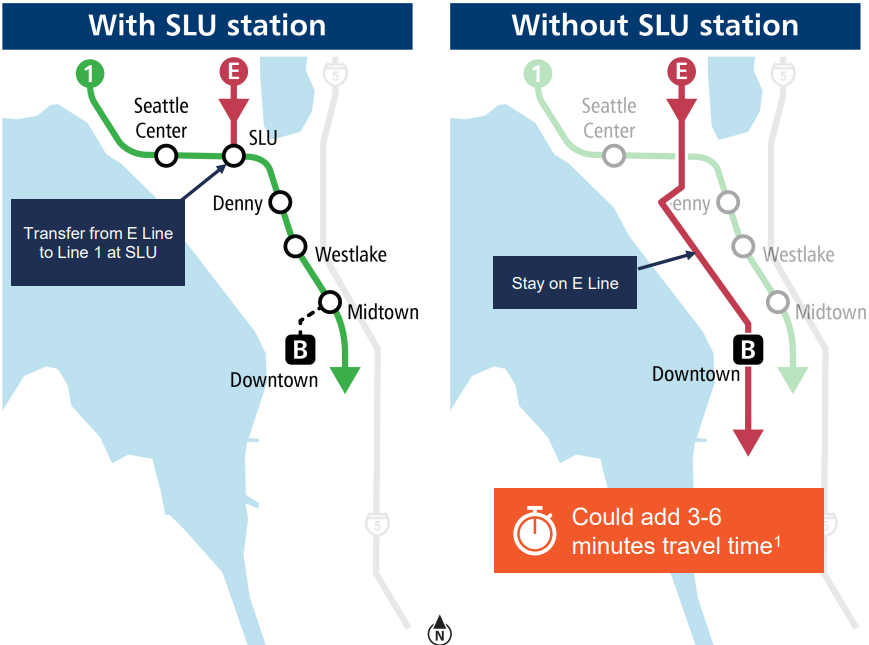
While Harrell has signaled he’s now leaning toward the Westlake Denny Station and Harrison SLU Station, other boardmembers continued to express interest in the Shifted West alternative despite everything they’d heard, including University Place Councilmember Kent Keel and Snohomish County Executive Dave Somers.
Climate goals and arena access
The last minute changes to Ballard Link combine to decrease access to Seattle Center, where Climate Pledge Arena and a soon-to-be-expanded Memorial Stadium attract huge crowds for games and concerts. Barrientos said the neighborhood is worried the arena will not meet its transportation and climate goals.
“You’d get Memorial Stadium impacts, which will be huge, and then you got an NBA team coming in, before the station is finished,” Barrientos said. “And what does that do to a neighborhood? It’s just insane to think that one station can handle that magnitude. And then of course, there was no consideration of climate targets — their goal is to get to at least 50% of all attendees arriving through public transportation. Well, how does that happen when you don’t have connections or access?”
Sound Transit did an initial study of crush loads for a confluence of major events at the Seattle Center, and found that the stations become very crowded, which led them to propose a metering system to prevent overcrowded platforms. They mention that metering could happen at the station entrance or at the event venue, which would obviously require the cooperation of said venue.
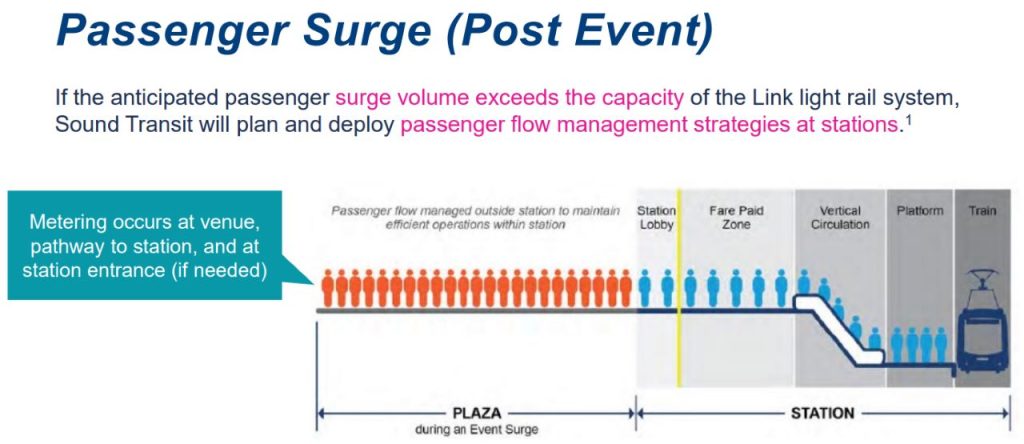
With such high demand for space to queue for a train after events, having more stations near the Seattle Center could do a lot to alleviate platform crowding and avoid a complicated metering system that sounds difficult to enforce and implement. For example, Memorial Stadium eventgoers would be more likely to head to the Harrison station given the proximity, which could lessen crush loads at Uptown Station.
Even attendees to Climate Pledge Arena or Seattle Center festivals may prefer to walk to the station that’s in the direction of their travel, especially if a proposal to shift the Uptown Station to the west also prevails, putting the stations more equally distant from the arena. When crowds into the 100,000’s are involved, having multiple stations in the vicinity is a good idea.
“And when there’s a post event at Climate Pledge Arena, and they only have the one station to go to, they’re going to have to probably manage the people getting on trains by metering people,” Frauso said. “And what that means is they let so many people down the escalator and on the platform. And then the trains got to go and they got to clear the platform. They bring another train and and then they let so many other people. So the impact of where are those people? Where are they being held? We don’t have that open space. Our streets aren’t that wide.”
Weigh in
Sound Transit is hosting two webinars to gather feedback on the South Lake Union station decision. The first is today at noon and the second is Tuesday, July 25 at 5:30pm. Links below:
“For more information about the upcoming webinars and how to attend, visit our online open house and sign up for our project email updates,” the agency said. Comments can also be sent to the Sound Transit Board at emailtheboard@soundtransit.org.
Doug Trumm is publisher of The Urbanist. An Urbanist writer since 2015, he dreams of pedestrian streets, bus lanes, and a mass-timber building spree to end our housing crisis. He graduated from the Evans School of Public Policy and Governance at the University of Washington in 2019. He lives in Seattle's Fremont neighborhood and loves to explore the city by foot and by bike.

